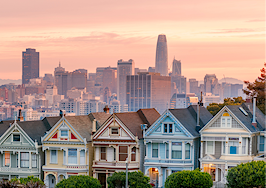The idea that the city is for condos and the suburbs are for homes with a big yard has been drilled into our collective understanding of real estate, but as sales of suburban condos soar, that idea is becoming less and less reflective of a changing market.
Amid historic inventory shortages across the United States, prices have soared across all types of residential real estate offerings — urban, suburban and rural. A recent Redfin analysis found that sales of suburban condos rose by 22.8 percent in the first 12 weeks of 2021, while prices rose by 20 percent.
Condo developments in close proximity to a major urban center are popping up in suburban areas across North America. Blackstone recently purchased The Archer, a 304-unit apartment complex in Cobb County outside of Atlanta. Stillwater Capital of Dallas recently proposed a 67.4-acre mixed residential and commercial project outside Colorado Springs. And in the Canadian city of Vancouver, a 141-unit new development in the suburb of Surrey (around 45 minutes outside the city) sold out within an hour of the developer opening pre-sale contracts.

Giralda Place
“Initially people assumed that the pandemic would cause condo sales to drop with people not wanting to get into elevators and all that,” Cristo Brown, co-developer of the newly-built luxury development Giralda Place in Coral Gables outside Miami, told Inman. “That was somewhat true in the beginning, but as people began to understand COVID more and vaccinations rolled around, we saw a dramatic increase in purchases.”

Gavin Cheung | CentreCourt
Traditionally, the overwhelming advantage that condo owners chose in exchange for a much smaller space has been walkability — being able to step outside and immediately access an urban area’s restaurants, shops, theaters and parks. While small and affluent cities like Coral Gables are built to offer all of that, other suburban condo developments would still have its residents relying on a car.
Jonathan Miller, president and CEO of real estate and consulting firm Miller Samuel Inc., said that the major spike in demand for suburban units has a lot to do with the current market. Historic inventory lows and rising home values are pricing many out of cities like New York and Los Angeles entirely, while a suburban condo can be a way for potential buyers to break into a market with a first purchase.
“The way to think of the city/suburban relationship is that it’s not a zero-sum game,” Miller told Inman. “The early default of single-family has evaporated with the two issues of affordability and a lack of inventory. Prices have gone up sharply for both single-family homes, and depending on the market, condos just over the last year, while there’s very little flexibility to lenders. Underwriting is much tighter than it used to be and, as a result, we are seeing all this build-up in pricing and activity.”
CentreCourt, a real estate developer and builder in Toronto, said that despite decades-long focus on the city’s centre, they have started strategically looking at surrounding areas — particularly growing towns with easy access to central public transit lines.
“While a sizeable majority of our projects are in the downtown, we will strategically develop outside of the core where the growth of the neighbourhood is compelling and where transit access is abundant – such as with our ‘WestLine’ project, which is situated adjacent to the future Downsview masterplan and steps from the Sheppard West Subway line,” Gavin Cheung, executive vice president of CentreCourt, told Inman.

Jonathan Miller
While statewide condo price statistics can be inflated due to ultra-high urban prices, their smaller size make them a more affordable option for many. In Washington, the median single-family home costs $437,442 while the median condo costs $368,134. In California, those numbers are closer ($588,050 for single-family compared to $525,594 for condos) but offer an alternative to million-dollar mansions in places like San Jose and San Diego.
Miller also pointed out that the condo lifestyle — having a pool and a guest space, paying maintenance fees and not having to worry about things like mowing the lawn or fixing the roof — may still be attractive to residents those who were priced out of urban markets.
“When you think about purchase activity in the suburbs, they largely came from urban rental markets — urban renters who become first-time suburban buyers,” Miller said. “Because of the plunging rates and at what in the early stages of the pandemic felt like the affordability of the suburbs, prices have risen in the suburban markets. Records are seemingly topped every quarter and month.”
As a result, many are broadening their search and thinking outside of traditional urban-suburban categories even if the appearance of affordability observed by urban residents at the start of the pandemic may no longer be relevant in many markets a year later.
Lakewood, New Jersey, a suburb of New York City, saw its average home price rise by 47.6 percent. An hour outside of Los Angeles, Lake Arrowhead saw its prices soar by 45.7 percent. Just as old ideas of city life versus suburban life have been permanently altered by the pandemic and the rise of working from home, the old view of the suburbs as an “affordable option” may also soon become obsolete depending on where you live, Miller says.
“The old idea [of people moving to the suburbs to have a big home] describes one segment of the population that made the move during the pandemic,” Miller said. “There are multiple stories that are driving this shift and a key complication is the affordability factor.”













